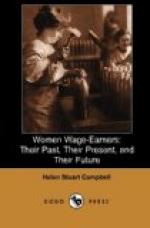Taking States in their alphabetical order, the census of 1880 gives the number of working-women for each as follows:[20]—
Alabama, 124,056.
Arizona, 471.
Arkansas, 30,616.
California, 28,200.
Colorado, 4,779.
Connecticut, 48,670.
Dakota, 2,851.
Delaware, 7,928.
District of Columbia, 19,658.
Florida, 17,781.
Georgia, 152,322.
Idaho, 291.
Illinois, 106,101.
Indiana, 51,422.
Iowa, 44,845.
Kansas, 54,422.
Louisiana, 95,052.
Maine, 33,528.
Massachusetts, 174,183.
Michigan, 55,013.
Minnesota, 25,077.
Mississippi, 110,416.
Missouri, 62,943.
Montana, 507.
Nebraska, 10,455.
Nevada, 403.
New Hampshire, 30,128.
New Jersey, 66,776.
New Mexico, 2,262.
New York, 360,381.
North Carolina, 86,976.
Ohio, 112,639.
Oregon, 2,779.
Pennsylvania, 216,980.
Rhode Island, 29,859.
South Carolina, 120,087.
Tennessee, 56,408.
Texas, 58,943.
Utah, 2,877.
Vermont, 16,167.
Washington Territory, 1,060.
West Virginia, 11,508.
Wisconsin, 46,395.
Wyoming, 464.
FOOTNOTES:
[17] Remarks on Tables of Occupations, Ninth Census of the United States, Population and Social Statistics, p. 663.
[18] June, 1893.
[19] The table is copied with minute care from that given in the last census; and while it shows one or two deficiencies, the writer is in no sense responsible for them, its accuracy, as a whole, not being affected by the slight discrepancy referred to.
[20] The tables in this department of the census for 1890 are not yet ready for the public; but the department states that the increase in women wage-earners averages about ten per cent.
V.
Labor bureaus and their work in relation to women.
The difficulties encountered by the enumerators of the United States Census, and the growing conviction that much more minute and organized effort must be given if the real status of women workers was to be obtained, had already been matter of grave discussion. The labor question pressed upon all who looked below the surface of affairs; and very shortly after the census of 1860 a proposition was made in Boston to establish there a formal bureau of labor, whose business should be to fill in all the blanks that in the general work were passed over.
Many facts, all pointing to the necessity of some such organization, lay before the men who pondered the matter,—factory abuses of many orders, the startling increase of pauperism and crime, with other causes which can find small space here. With difficulty consent was obtained to establish a bureau which should inquire into the causes of all this; and the first report was given to the public in 1870. It was descriptive rather than statistical, and necessarily so. Methods were still a matter of question and experiment. The public had small interest in the project, and it was essential to outline, not only the work to be done, but the reasons for its need.




